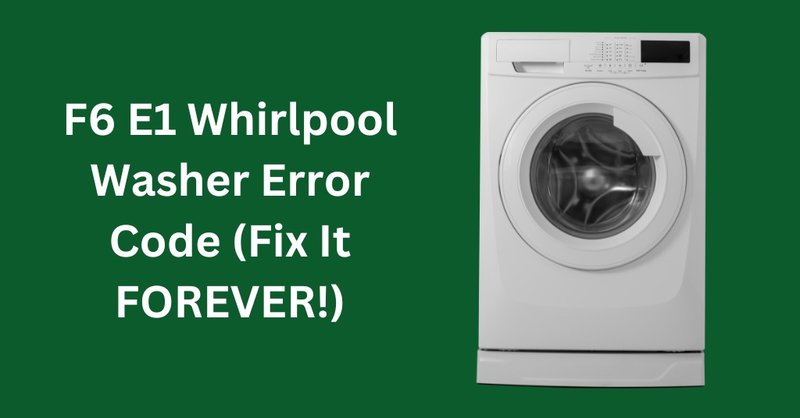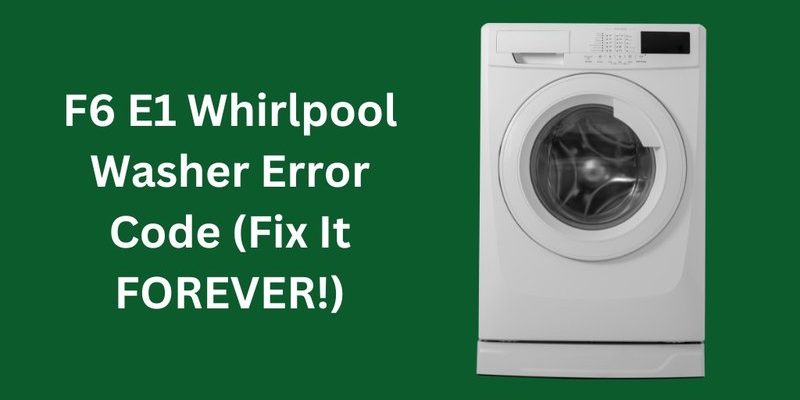
You’ve probably encountered situations where something doesn’t work quite right, like when your phone runs out of battery in the middle of a call. Similarly, error codes on appliances are like secret messages informing you there’s a hiccup in the system. Specifically, the E1 error code in Whirlpool washing machines typically refers to an issue related to the water supply. This might be as simple as a blocked hose or a tap not being fully open. Think of it like trying to fill a glass of water but forgetting to turn on the faucet—a bit frustrating, right? But don’t worry; you just need to take a closer look at the potential causes and how to fix them.
Understanding the E1 Error Code
So, what exactly is happening when this E1 code pops up? To break it down, the E1 error code generally indicates a problem with water not entering the machine as expected. Your washing machine relies on a steady stream of water to function properly, and if there’s anything impeding this flow, it’ll let you know through this code. Imagine trying to shower with a dribble of water; it wouldn’t be effective, and you wouldn’t get very clean. Similarly, your washing machine needs adequate water to perform its wash cycles.
One of the most common culprits behind the E1 code is a water inlet issue. This is like the entry gate for water into your machine. If the inlet valve isn’t working correctly—maybe it’s stuck or blocked—water can’t flow into the machine as it should. Another potential problem could be low water pressure, which is like trying to pour soda from a nearly empty bottle. If your water supply is weak, the machine can’t fill up within the allotted time, triggering the E1 code.
Now, you might wonder, “Is my washing machine broken?” The good news is, not necessarily! Often, these issues are minor and can be fixed without professional help. Before you called in the cavalry, it’s a good idea to check a few things yourself.
Common Causes of the E1 Error Code
Chances are, this error is due to something simple and solvable. One of the first things to check is the water supply taps. Believe it or not, sometimes they’re not turned on fully. It’s like trying to water your garden with a kinked hose—it just won’t work effectively. Ensure that the taps supplying water to your machine are fully open.
Another possibility is that the hoses have become twisted or kinked. A kinked hose restricts water flow, similar to how stepping on a garden hose stops the water. Unkink your hoses and make sure they’re properly connected. It’s a simple fix that might just do the trick.
Additionally, the water inlet valve might be blocked. Consider it the gated access to your house. If blocked, nothing can get through. This might require cleaning or replacing the valve. In some cases, sediment or debris builds up over time, restricting water flow.
How to Fix the E1 Error Code
Ready to dive into fixing it? Let’s start with the water taps: make sure they are fully operational and the water pressure is adequate. If you’re not sure about the pressure, check if your other faucets are running well. Low pressure across all taps might suggest a broader plumbing issue.
Next, inspect the hoses. Pull out the washing machine carefully and check the hoses for any kinks or twists. Straighten them out and reattach them securely to the taps and the machine. You might be surprised how often this simple adjustment resolves the issue.
If the E1 code persists, it might be time to examine the water inlet valve. First, unplug the machine for safety—nobody wants a shock while tinkering with appliances! Then, examine the valve for any visible blockages or debris. Cleaning or replacing the valve may require a bit more effort, but it’s a doable task with some online guidance or the help of the user manual.
Preventing Future E1 Errors
Once you’ve solved the immediate issue, it’s smart to think about preventing future headaches. Regular maintenance is key. Consider checking your hoses and water supply connections every few months. This way, you can nip potential problems in the bud before they escalate to error codes.
Cleaning the water inlet valve periodically can also help. Think of it like regular home cleaning or car maintenance; a little care goes a long way. Keeping the valve free from sediment ensures smooth water flow, much like keeping a sink drain clear of clogs.
Additionally, if your area has hard water, using a water softener can reduce mineral buildup. It’s like using conditioner in your hair to keep it soft and tangle-free. Such preventative actions might save you from future unexpected interruptions while doing laundry.
Remember, while the E1 error code might initially seem like a daunting adversary, it’s often just a minor issue that can be resolved with a little bit of elbow grease and attention. By understanding the causes and fixes, you can confidently tackle this error, ensuring your washing machine is back to keeping your clothes fresh and clean in no time.
